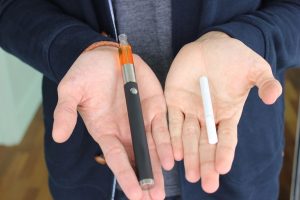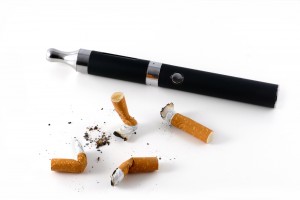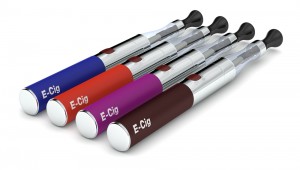This blog post reflects the author’s personal experience.
Day 1. Saturday 28th September 2013, 1.21pm. Inadvertent quit date.
It didn’t cross my mind for a second that this would be my last cigarette. Whilst I’d been away at a (tobacco control) conference, my husband had, out of the blue, decided to invest in an e-cigarette. That was four days ago. He hasn’t had a cigarette since. So, today, I decided to finally invest. I’m a pretty heavy smoker (~25 per day), and have been for about eight years (I appreciate the irony of this, having devoted five years of my life to the study of tobacco dependence). Anyone who has been unfortunate enough to fly long-haul with me will testify just how horrendous I am to be around without tobacco. Ditto my colleagues who’ve experienced my wrath after enlisting me as guinea pig in any experiment involving overnight abstinence. Anyway, I digress. I visited a local store dedicated to the sale of e-cigarettes (‘e-cigs’). Now I’m pretty au fait with the literature on these things. I had lots of questions (mainly relating to vapour composition and actual nicotine delivery), to which I didn’t really receive any satisfactory answers (the general public must not press with such line of questioning – they offered me a job in the store!). But I did learn a lot about the mechanics of these things, and tried out a lot of flavours. Seriously, you have a lot of options! I tried cherry, apple, mango, kiwi, very berry, raspberry, candy floss, blueberry, cherry cola, grape, and barely scratched the surface. There’s also an extensive range of tobacco flavours, dessert flavours (cheesecake anyone?!), rum, beer (?!); the list goes on… I was pretty stunned at the variety. But, in the end, I settled for blueberry and cherry cola. These flavoured nicotine solutions come in several strengths. I was advised, as a 25 cigarette per day smoker, to go for the 18mg mix. So, e-cig ‘starter pack’ in hand [pic], I carried on running my Saturday errands. Three hours later, I suddenly realised I hadn’t had (or wanted) a real cigarette. Now, honestly, it was not my intention to give up smoking. I was just curious (from both a personal and professional perspective) and thought this device might be a useful travel aid. But hey, why not see how long I could run with this? My husband was doing incredibly well so far, so why shouldn’t I try too. So how was I feeling at this point? A little restless. My throat was a little sore. But I wasn’t feeling irritable. I’ve tried giving up before. Nicotine gum, inhalator, bupropion – on all of these, giving up smoking had taken over my ENTIRE LIFE. Cigarettes were always on my mind. Today, that hasn’t been the case. But I have felt like something has been missing. For some reason I’ve been craving the scratch of metal on flint (my trusty clipper, a.k.a. conditioned reinforcer). ‘Smoking’ inside has been a novelty though. I guess I’ve been enjoying the novelty of it all. The cravings kicked in in force after dinner, but a 15 minute ‘vaping’ session helped check them. And yet I didn’t feel totally satisfied… A night in, watching back-to-back episodes of ‘24’, kept me suitably distracted and on track though. Oh, and I downloaded a stop smoking app to keep track of my progress – more on that tomorrow…

Day 2. Sunday 29th September 2013.
I knew this was going to be hard. The first cigarette of the morning has always been my favourite. For eight years, the first thing I’ve done every morning, without fail, is roll out of bed, head down to the kitchen to roll a cigarette, and sit out in the garden to smoke. That was all I could think about when I woke up. So, this morning, I went out and sat in exactly the same place, and spent 10 minutes vaping. It wasn’t the same, but it helped. I spent almost half of my morning puffing away on that thing (I’m curious to know what my total daily inhalation volume is). I’ve also been really hungry today. We decided to head down to the pub to treat ourselves to a Sunday roast. This was going to be hard – two glasses of wine and a big lunch. We sat out in the garden for half an hour afterwards. That thing was glued to my mouth. But I didn’t crack. When we got home I ended up taking a four hour ‘nap’ (I should add, my sleep has been pretty irregular, and I’ve been having very lucid dreams). I woke up with a dry mouth (again, that’s becoming a pretty regular feature), and a deep sense of incompleteness. More vaping. I’m writing at 11.24pm, and my stop smoking app informs me of the following:
Time since last cigarette: 1 d 10 h 03 mins
Money saved: £7.98
Not smoked: 35.48 cigarettes
Time saved: 0 d 3 h 32 mins
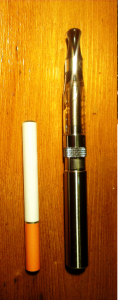
Day 3. Monday 30th September. Hell hath no fury like a girl without cherry cola flavoured nicotine.
Today has been the hardest day to date. I woke up, after a disturbed night’s sleep, from a particularly violent and lucid dream, with a painfully dry mouth. Reaching for an (empty) glass of water, I noticed the time. ****. I was horribly late for work (read: I have a meeting in 20 minutes and even if I jump straight into the car now I’ll still be late). Thirsty, flustered, and desperate for a cigarette, I flew into a whirlwind, got ready in 25 minutes (a record), and leapt into the car, ready to vape the hell out of that magic stick. However, two deep breaths in, the battery dies on me. Damn. I’m already 40 minutes late at this point. I get to work, park up, and run to the supermarket round the corner. I’ve devoted way too much effort to this cause to give up now. So instead of buying tobacco (the cheaper option by the way), I invested in a disposable e-cigarette. Now this model is very different to the one I’ve been using. It actually looks like a cigarette (see pic). No charging and no refilling needed. So I tear open the packet and start puffing away whilst running into work. It tasted DISGUSTING. I forgot to add, this e-cig was tobacco flavoured, not the fruity concoction I’m starting to grow used to (is cherry cola becoming a new conditioned reinforcer for me?!). I think this was the first time it hit me that my sense of taste had returned in force. Anyway, this hit the spot. Despite the vile taste in my mouth.
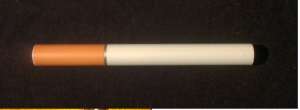
A day of data analysis ensues. I have a growing sense of unfulfilment. By 5pm I am in a terrible mood – irritable, hungry, restless. Driving home, my new e-cig, supposedly equivalent to 20 cigarettes, containing an advertised 16mg of nicotine, starts tauntingly flashing at me, before promptly giving up the ghost. At this point I should highlight that I’ve been going through about 2.5ml a day of a solution that contains 18mg nicotine per 10ml bottle. Now, I haven’t been keeping tabs on my circulating nicotine and cotinine levels (I should have been), but a moment of grumpy mental arithmetic en route home tells me something is amiss here. If the advertised nicotine content is correct, then the actual nicotine delivery of these things must wildly fluctuate across models (we know this to be true). So anyway, I get home, disproportionately angry that my husband hasn’t bought baked beans, and spend the next 15 minutes glued to his (cotton candy flavoured) e-cig while mine charges. At the shop (buying beans), I feel a quiet satisfaction in not adding a pouch of tobacco to my basket at the counter. It’s now 7.26pm:
Time since last cigarette: 2 d 6 h 05 mins
Money saved: £12.68
Not smoked: 56.35 cigarettes
Time saved: 0 d 5 h 38 mins
Day 4. Tuesday 1st October.
Nothing much to report today, other than generally feeling a bit tetchy and low, for no real reason. That’s new I guess. And my throat is still a bit sore. Night.
Day 5. Wednesday 2nd October.
So today I passed the 100 cigarettes not smoked mark. That feels pretty damn good! This morning also marked the first morning to date that I’ve woken up and haven’t been desperate for a cigarette. I still wanted one, but I didn’t feel like I needed one. And that is a big deal, at least to me. I also managed to resist the urge following a night out with friends, despite a lot of curry and a lot of wine. Jen 1, tobacco 0.
Day 6. Thursday 3rd October.
I think I’m getting used to this now. I also realised that I’m not so reliant on my e-cigarette anymore. I mean, I’m still using it a lot, and definitely devoting more time to it than I ever did with cigarettes, but it’s not permanently glued to my mouth today. I did have one particularly big craving to smoke today after an argument on the phone – definitely the biggest craving since day one. But that soon passed. I think the increasing brevity of these posts stands testament to the fact that this is getting easier. It’s now 9.25pm:
Time since last cigarette: 5 d 8 h 04 mins
Money saved: £30.02
Not smoked: 133.40 cigarettes
Time saved: 0 d 13 h 20 mins
Day 7. Friday 4th October.
I encountered my first bar tonight that prohibits e-cigarette use. I asked why this was and was informed that “people get very drunk and we’re worried that people might see other people smoking e-cigarettes and think it’s ok to smoke real cigarettes inside too”. Hmm…
Day 8. Saturday 5th October.
My throat is KILLING me. I was genuinely in agony when I woke up this morning. My teeth have been hurting a lot too. They’ve been pretty sensitive since I had them bleached a couple of years ago, but the pain has flared up in style recently. Coincidence perhaps? Obviously association does not imply causation, but, the vapour is very sweet tasting – need to check which sweeteners are used in that nicotine solution… By the way, today marks one entire week tobacco free! It’s 12.21pm.
Time since last cigarette: 6 d 23 h 01 mins
Money saved: £39.15
Not smoked: 173.99 cigarettes
Time saved: 0 d 17 h 23 mins
Day 10. Monday 7th October.
So my teeth feel fine again now. But for the last couple of days I’ve really had a sore throat – so sore that I’ve been putting off using my e-cig until I’m literally desperate for nicotine. And my nose has been running, constantly. I’m not sure if this is just my airways clearing themselves, a side effect of the e-cig, or just a cold. Whichever it is, I decided to try and remedy it by really heavily cutting back on my vaping today, and to patch up the withdrawal with nicotine lozenges. That actually seems to be working pretty well. Let’s see how the throat fares tomorrow… It’s 8.55pm:
Time since last cigarette: 9 d 07 h 34 mins
Money saved: £52.40
Not smoked: 232.89 cigarettes
Time saved: 0 d 23 h 17 mins
Day 12. Wednesday 9th October
My throat feels fine. However, my e-cig is a long way from fine. In fact, it tastes like burnt metal. I’m no expert on these things, but from what I can tell the heating element has burnt out. I was told this would only need to be replaced every two months, but I guess I’ve been using it a lot, particularly during week one. Anyway, this means I ended up stuck at work without any withdrawal soothing vapour. But I did have a pack of nicotine lozenges on hand as back up, and you know what? I actually did pretty well on those today. And I have a back up mouthpiece at home, so life is good.
Day 13. Thursday 10th October
Absolutely nothing to report today, other than passing the ‘1 day of my life saved’ milestone (Fun fact: Adults between the ages of 25 and 34 years who quit smoking gain around 10 years of life compared to those who continue to smoke! More info here). Oh, and I’ve just read back through this blog for the first time. It feels pretty good to have come this far! It’s now 11.11pm.
Time since last cigarette: 12 d 09 h 50 mins
Money saved: £69.81
Not smoked: 310.26 cigarettes
Time saved: 1 d 07 h 01 mins
Day 16. Sunday 13th October.
I feel like I’ve spent a lot of this blog complaining about my teeth. But I have to mention it again, because I’ve started to notice a trend – they only seem to start hurting when I’m using the Cherry Cola flavour solution. No problems with Blueberry. There’s no information as to exactly what ‘flavourings’ consist of in these solutions on the company website. I’m going to dig deeper on this. Also, another observation: I seem to be much more sensitive to the effects of alcohol since quitting smoking. Two glasses of wine really have been knocking me for six. Anecdotal evidence, of course, although my husband has independently also made the same connection. Is there any research into this?! A five minute literature search does indeed suggest that nicotine decreases blood alcohol concentration! Surely this information needs to be publicised more widely for clear safety reasons… It’s 10.19pm:
Time since last cigarette: 15 d 08 h 58 mins
Money saved: £86.48
Not smoked: 384.35 cigarettes
Time saved: 1 d 14 h 26 mins
Day 19. Wednesday 16th October.
Why do I always leave it to the last minute to pack for holiday?! Super quick update today. It’s 12.29am:
Time since last cigarette: 18 d 11 h 21 mins
Money saved: £103.86
Not smoked: 461.62 cigarettes
Time saved: 1 d 22 h 09 mins
Day 20. Thursday 17th October.
HOLIDAY! Operation mini-break is go. I’m currently sitting at the airport. For some reason, I am DESPERATE for a cigarette right now – more so than I have been all week. I’m pinning this to one of two reasons: 1) I actually can’t have a cigarette right now (rather than just choosing not to); or 2) Whenever I’m at an airport I’m always in some growing state of nicotine withdrawal, and now my surroundings are basically acting as cues to provoke the deep state of unrest with which they’ve become associated. Possibly both. Plus I’m drinking coffee, which always makes me want to smoke.
Day 34. Thursday 31st October.
Woah. It’s been a REALLY long time since my last entry. I’ve been meaning to squeeze in an update for ages but a back-to-back holiday, business trip, and unexpected stint in hospital have all gotten in the way (incidentally, not having to drag a drip outside every hour for a smoke has definitely been an unexpected bonus to quitting). So…update. And this is going to be my final entry, as I only planned to keep this diary going until the 1 month mark.
Today marks my 34th day smoke-free. I am genuinely feeling pretty proud of myself, given that the longest I’ve gone without tobacco in the last eight years is a little under 24 hours. It hasn’t been easy. There have definitely been times when I’ve been desperate for a cigarette. And I have begged friends for a drag whilst out (they refused, for which I was grateful, at least the next morning). However, I have not (yet) slipped at all, which is pretty great considering I never even intended on quitting in the first place.
I also wanted to sum up on my experiences of quitting using an e-cigarette. Firstly, I should make it clear that I almost certainly wouldn’t have been able to quit without these. As I said in one of my first entries, I have tried a LOT of different cessation methods before, and failed royally with each every time. However, I also have some concerns. Before starting this experiment, I felt quite strongly that these products shouldn’t come under MHRA regulation. Why should products which seem to be proving to be so helpful in getting people off cigarettes be regulated more tightly than cigarettes themselves? However, over the course of the last month it has become very clear that some regulation of e-cigarettes is certainly warranted. There is a huge degree of variability between brands and models, for example, in terms of actual nicotine delivery. I have also experienced a number of negative symptoms which have coincided with the use of these products. These have ranged from the relatively minor (e.g., dry mouth, sore throat, and tooth ache, as discussed), to the more serious (e.g., coughing up bloody phlegm, as I rather worryingly experienced last night). All in all, however, I really am in favour of these devices. But for now, I think I’ll be switching to nicotine lozenges. It’s 3pm. My final stats are:
Time since last cigarette: 33 d 02 h 39 mins
Money saved: £186.25
Not smoked: 827.78 cigarettes
Time saved: 3 d 10 h 47 mins
P.s. If you’re interested in learning more about e-cigarettes, you might want to check out this briefing, recently released by Action on Smoking and Health.
This article is posted by Jen Ware

